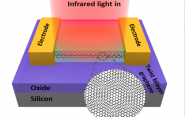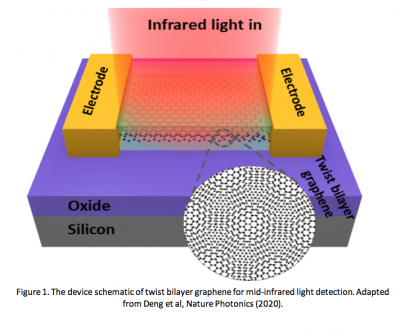With a Twist, Researchers Make a Device Breakthrough

In recent years, researchers have found that when certain materials are twisted at specific angles, they can bring out some remarkable properties.
 Putting their own spin on this field of research, known as “twistronics,” a team of researchers has found that similar methods can elicit properties that could lead to new optoelectronic devices. The work is a collaboration between the laboratory of Fengnian Xia, the Barton L. Weller Associate Professor in Engineering and Science at Yale University; Professor Fan Zhang’s group in University of Texas at Dallas; Kenji Watanabe and Takashi Taniguchi of National Institute for Materials Science, Japan. Their results were published this week in Nature Photonics.
Putting their own spin on this field of research, known as “twistronics,” a team of researchers has found that similar methods can elicit properties that could lead to new optoelectronic devices. The work is a collaboration between the laboratory of Fengnian Xia, the Barton L. Weller Associate Professor in Engineering and Science at Yale University; Professor Fan Zhang’s group in University of Texas at Dallas; Kenji Watanabe and Takashi Taniguchi of National Institute for Materials Science, Japan. Their results were published this week in Nature Photonics.
By twisting two atomic layers, researchers have been exploring the various novel physical phenomena. A particularly interesting material system in the field is what’s known as small-twist-angle bilayer graphene. It consists of two layers of graphene - each the thickness of one atom - twisted at an angle of less than 2 degrees. This twist significantly modifies the electronic properties of monolayer graphene. Among the properties that researchers have discovered are superconductivity and certain topological properties.
However, little research has been done on how it affects a device’s response to infrared light. Taking this approach, the Xia group and collaborators found that the emergence of the moiré pattern in twisted bilayer graphene (TBG) leads to a device with a very strong, and tunable, photoresponse in mid-infrared wavelength range. Compared with regular bilayer graphene that hasn’t been twisted, the photoresponse is more than 20 times stronger. That's because this twist significantly enhances the light-matter interaction and induces a narrow bandgap. It’s a particularly interesting result, since almost all matters at room temperature emit light in this wavelength range.
Critical to achieving these results is the specific angle at which the layers are twisted. After fabricating and measuring several devices with various twist angles, the researchers found that a TBG device exhibits the best result when twisted at an angle of about 1.8 degrees. Such promising optical properties could provide an alternative material platform for tunable mid-infrared optoelectronics, such as efficient photodetection, light modulation and imaging. The researchers further investigated the origin of the photoresponse, and the bolometric effect was identified as the origin. In short, the incident energy in photons is absorbed by the twisted bilayer graphene, leading to its enhanced temperature. As the material conductance varies when temperature changes, the photocurrent emerges.
Bingchen Deng, the first author of the study, and co-author Chao Ma - both Ph.D. students in Xia’s lab - said the next step is applying similar methods to different materials to see what properties they can discover. In particular, this includes optical properties, since the lab has developed the full capability of conducting low-temperature infrared optoelectronic measurements over the years.

